Luis Cortés: Esperanza builds an ‘opportunity community’ for Latinos in Philadelphia
Don’t tell the Rev. Luis Cortés that Esperanza is something special.
It is, of course. And he appreciates the compliment. But he doesn’t think that an institution like Esperanza, which serves the Latino community in North Philadelphia, should be special.
“A place like Esperanza should be normative. We have 30 neighborhoods in the city; there should be 30 Esperanzas,” he said. “There should be 30 places where you can participate in the arts, where you can learn about and play music, where you can experience different forms of dance, where you can learn photography, where you can learn how to add and subtract.”
Just because people are poor doesn’t mean they shouldn’t have the same things that everyone needs for a good life, he said.
Founded in 1987, Esperanza seeks to help the residents of Hunting Park, a majority-Latino neighborhood, have the same opportunities that other residents of the city enjoy. It focuses on education and economic development, including affordable housing, schools, housing counseling, immigration legal services, workforce development, youth leader training, and a fully accredited branch campus, Esperanza College of Eastern University.
The organization — its name means “hope” in Spanish — has more than 600 employees and a budget of more than $70 million and is a model for other institutions across the country.
Cortés, who is a Baptist pastor, worked with Hispanic Clergy of Philadelphia to found Esperanza. He earned an M.Div. at Union Theological Seminary and a master’s degree in economic development from Southern New Hampshire University.
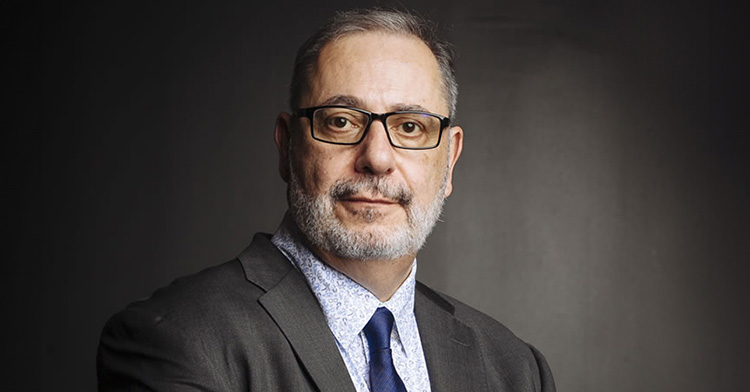
In this interview, he talks to Faith & Leadership’s Sally Hicks about why he founded Esperanza and why he thinks institution building is key to social change. The following is an edited transcript.
Faith & Leadership: You have a goal of building an “opportunity community.” What do you mean by that?
Luis Cortés: Our ontology has a set of concepts and categories, and the relationships between these are fundamental. There is a Creator, and there are the created. Those are givens, as fact. So we start there. The other thing that’s given, as fact, is that all human beings are equal in God’s eyes.
If you believe that, then you must believe that we should try to provide a great opportunity for everyone to become that which God would have them become. To be in service to humanity is to assist everyone to develop to their highest potential. That’s our modus operandi.
This understanding then is followed by the question, what do you do with the poor? The mission work is to create a place where you provide all residents the opportunity to live a quality life. What must you provide for people to reach their ultimate goals, to be able to serve humanity better despite their economic situation and to have them feel they have a good quality of life?
This is what becomes an opportunity community, the development of all things needed for individuals to reach their potential. As an example, we built a theater and we have cultural pieces, like teaching dance, teaching music, all from a cultural perspective.

All people come from and have a culture. We have a language, we have music, and for Latines, we are in exile — we’re away from where our culture was based.
What do we do to create an opportunity community — a community that understands your class and your culture and helps you build so that you can have a great life staying here in this neighborhood or you can use what you learn here and have a great life elsewhere?
F&L: How did Esperanza begin?
LC: I was the founder of Hispanic Clergy of Philadelphia in 1981, an outgrowth of developing a field education system for Latine students at Eastern Baptist Theological Seminary. It was about 26 clergy from about 18 different denominational entities.
These clergy were all in the same Philadelphia neighborhood, and they had never really worked together until we organized as a field education consortium. As a group of clergy, when we would get together, like any group of highly motivated concerned citizens, we inevitably become active on challenging issues of the day.
We were getting together to discuss field education, quite mundane. And then all of a sudden, conversations shifted to, “They shot a guy here last week” or, “The police did or didn’t perform,” and we just moved in the direction of the conversations and became a civil rights organization.
During that time, Pew Charitable Trusts did a study on religious institutions, and as a result, we got funded for three years to start Esperanza and to work in clergy education. The clergy hired me to do it, with the mandate to do the clergy education and create a proactive organization, Esperanza.
In the beginning, the more we helped an individual family, the more it hurt the local church. As we helped individuals, the family moved farther away from their church, eventually joining a suburban congregation.
What we learned as a group was, it doesn’t matter if our people leave to improve their lot, as long as we create an institution that remains to assist those that stay or can’t get out.
Our philosophy became that we will work together to create Hispanic-owned-and-operated institutions. We began working on that theory of institution building where we could control the mission and agenda of our community, as opposed to the present-day external control.
We as Hispanic people in this nation have never focused on this on a large scale. We’ve never created our own institutions. What we do is we assume that we will inherit the institutions of America as we become a larger part of America. But that is not how it works. The institutions that provide for and control our neighborhoods are all managed externally: police, fire, schools, streets, most businesses.
So we decided we only wanted to create Hispanic-owned-and-operated institutions. We had enough Hispanic institutions that were doing social service, so we decided to not compete with our follow Latine agencies. We focused on education and economic development.
We wanted to do education because education is the first step and we understand institution-building as economic development.
When we first got started, it was like, “How do we help people?” Now it’s, “How do we help our institutions help people?”
F&L: How did you come to appreciate institutions in this time when there’s a lot of cynicism, a lot of distrust, a lot of anger around institutions?
LC: Since our nation’s beginning, Alexis de Tocqueville noted that it is associations and the institutions that they create that make Americas unique.
We’ve got to think positive. We serve our communities and our neighbors. So if everybody would do as well as they can at their community-serving job, whatever that is, we should be headed to a better place.
As the religious population lessens, there will have to be alternative institutions that defend the rights of the poor. Historically, the church has responded to the poor first through charity, then the development of institutions like hospitals or schools. Advocating to change unjust laws.
If that faith role dwindles, we have to figure out who or what replaces that. I see that as a major problem for the future.
F&L: In addition to the institutions, you are making change in individuals. The documentary “Esperanza: Hope for Our Cities,” for example, shows that commitment. Why do you stress self-belief, grit and confidence?
LC: I went to public school in Spanish Harlem. When I got to elementary school, they said to me, “You can be president of the United States.” And I looked around, and it’s old, it’s decrepit, it’s dirty, it’s outdated, and I’m like, “Nah, no way.”
For many people, it’s hard to self-motivate if you don’t see anyone else around you achieve success. We need our youth to “make it.” Last year, in our graduating high school class, we had MIT, two people at Carnegie Mellon, and one girl went to Wellesley, among a plethora of state colleges and universities. It is now normative.
Part of our model is we must have modern equipment. The space must be super clean. Visitors come to our place and they say, “Wow, this is so clean.” It’s a compliment. I understand. But it also says something about their expectation.
When I’m told, “Wow, this place is clean. This lab is so modern,” what are they saying? That in their preconception of economic poverty, they did not expect a first-class lab here. They did not expect, because of the economics, this place to be spotless. They do not expect your top five students to go to those schools, and you have one of the top college-graduating high schools for Hispanics. They do not expect that.
Whatever prejudice they brought in begins to be challenged, right? It’s like — look at this: MIT, Harvard, Penn. When they see that, they say, “Something special is happening.”
While there may be truth to that, it’s only special because other people won’t do it. Our team at Esperanza figured out how to do it, creating a culture of opportunity.
I believe there’s nothing that we can’t do. It’s just about how much time you have and what are your priorities. People ask me about this all the time — “How did you do it?”
Well, you find the need and fill it. And once you fill it, create an institution behind it, then find the next need and fill it. And once you fill it, create an institution that survives until it can thrive.
F&L: You mentioned the cleanliness, and you also insist on giving Esperanza’s students and other participants the best in other ways. Why is that important?
LC: We start with the concept that we should have what any community has. If you look at most communities and the arts, for example, they have access to experiences and ways to learn; they have ways to experience music, acting, dance and painting or visual. We have to create the avenues.
First we got the theater, and then through the theater, we do dance. But we also brought the best of the region. So the Philadelphia Orchestra plays at our theater; Opera Philadelphia sings in our theater; the Philadelphia Chamber Orchestra plays at our theater; Philadanco and the Philadelphia Ballet dance in our theater.
We communicated to these arts institutions, “When you come to our neighborhood, it has to be your A team.” Normally when they go to a community, they send the B and C team so they can work and practice as they serve a neighborhood project. At Esperanza, if the A team ain’t coming, you don’t come.
The artistic talent also has to give time during the week to work with students. Not just Esperanza schools, but there are about 10,000 public school children in our neighborhood. They do workshops and our community youth interact with them. After their theatrical performance, they sit and answer audience questions for 15 minutes. We have found the arts groups love these interactions as much as our residents do.
F&L: You also work on gentrification. How much of an issue is that for you?
LC: The bottom line is that urban communities near centers of our American cities where working-class Spanish-speaking people live are being dismantled by an upper middle class and above who wants their land and their housing so they can capitalize economically and culturally. It is happening everywhere.
Cities are happy with the gentrification or displacement of our neighborhoods, because it means a better tax base for the city. So when the city gains, the economically disadvantaged lose. That’s a constant struggle.
We need to build up equity in Black and brown communities. The No. 1 equity builder in Black and brown communities is not giant companies; it’s mom-and-pop commercial shops and home ownership. What we can show is, as we lose the housing, these mom-and-pop shops are destroyed.
So, the real question is, do we really want to help Black and brown people, or are we just saying we do while we actually cash in on their assets?
In America, they’re taking our neighborhoods under the guise of mixed income communities. In St. Louis, Black neighborhoods are being bought up by universities. West Philadelphia, it’s universities and science centers. North Philadelphia, it’s another university and the corporate needs. So they push people out of their long serving neighborhoods.
Today, young professionals don’t want to spend money on a car to live in the suburbs. They prefer to live in the city, not have a car. They’ll just Uber and use the money saved on transportation for restaurants and recreation, which is fine. But the economic burden falls on the economically disadvantaged, who need to move farther away to more expensive housing, losing the businesses that cater to their needs.
It’s interesting that progressive communities are the ones that gentrify Black and brown neighborhoods. It’s not the conservatives. Conservatives avoid minority communities, while progressives enjoy moving into a culturally mixed neighborhood until they extinct the original ethnic group that was there.
Progressives move in during their early professional career, purchase housing cheaply, live there for five years and make six figures on their “investment.”
It’s a real interesting dynamic where we fight the conservatives on one side and we have to fight the progressives on the other. They do have one thing in common: they’re white.
The role of the church should be different. How do we talk to progressives to say, “Listen, I know you can make money by moving into my neighborhood, but you’re hurting us. How do we really build a mixed income community?”
There’s a dynamic that’s happening in our country. San Bernardino, Phoenix, Calle Ocho in Miami, San Antonio, Philadelphia. Chicago, with three distinct Hispanic neighborhoods. They’re all under the same pressure.
F&L: How do you keep from being overwhelmed when everything you describe is extremely complex? It’s difficult. Yet almost 40 years later, you’re still hopeful.
LC: I am a minister. I believe in God. And in the end, we are all called to serve others. Despite all the problems, our job is to persevere and pursue. And persistence is the name of the game.
When we first got started, it was like, “How do we help people?” Now it’s, “How do we help our institutions help people?”
In 2011, the Rev. Paul Abernathy, then an Orthodox priest fresh out of seminary, started a neighborhood ministry in the Hill District, a predominantly Black section of Pittsburgh that had long suffered from economic decline. He did what he could to make an impact: providing food and clothing, offering comfort or a prayer when someone was in distress. But he soon realized there were even deeper needs.
“What really struck me early on,” Abernathy said, “was the immense amount of suffering.”
A person would come in asking for help getting a doctor’s appointment or a bus pass and would end up talking about eviction, gun violence, systemic racism, unemployment, food insecurity, abuse, addiction or incarceration.
The serious experiences that came up all represented ongoing traumas. It reminded Abernathy of the post-traumatic stress he had been warned about when he was an Army staff sergeant in Iraq. Moreover, the traumas affected everyone in the neighborhood.
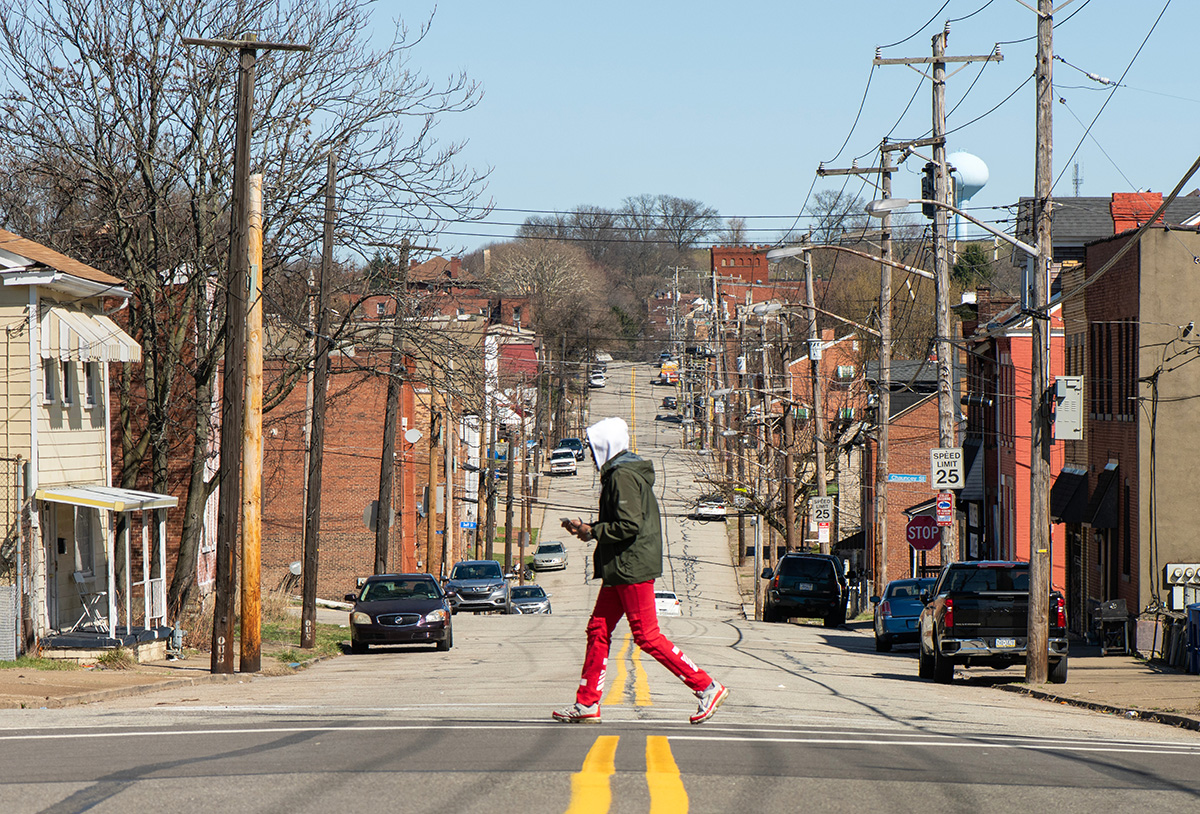
“Even if someone didn’t have a direct experience of trauma, that trauma was all around, all the time,” he said.
Abernathy, who is African American and was raised Catholic, attended a Black Baptist church in college before converting to Orthodoxy in 2002. He became convinced that unless that underlying suffering could be addressed, any efforts to help his constituents wouldn’t last.
“I’ve seen too many people get jobs and lose jobs,” he said in a 2016 TEDx talk. “I’ve seen too many people get into housing and lose housing. Why? Because they have been traumatized to the point that they are not healthy enough to sustain the opportunities that were placed at their feet.”
True community development, he came to believe, first required healing.
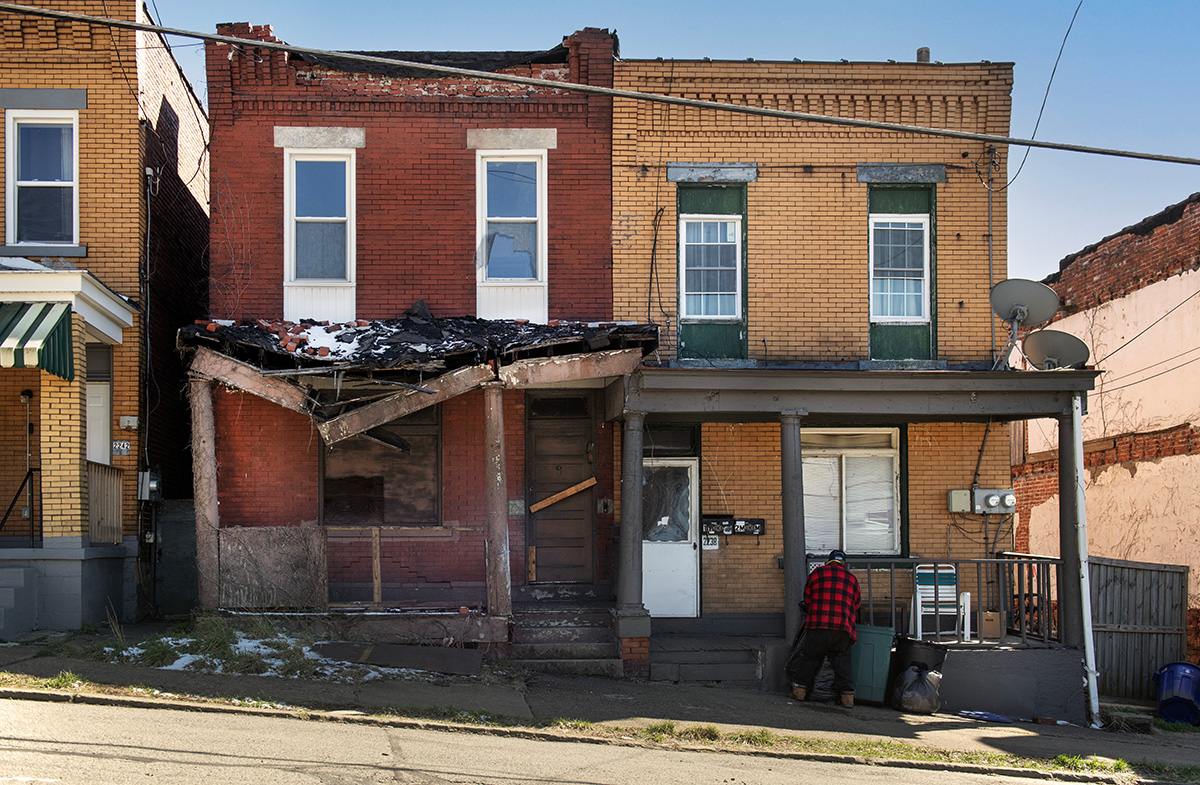
Abernathy found two researchers at nearby Duquesne University who were specialists in trauma counseling and community mental health and facilitated a series of discussions with them and community members.
He learned that 65% of African Americans have a lifetime exposure to trauma — long-term, repeated experiences that are stressful or frightening. He learned that trauma can be passed from generation to generation, with tangible effects on health. According to data from the National Center for Health Statistics, the average life expectancy in parts of the Hill District is nearly 20 years less than in the city’s wealthiest neighborhoods.
These discussions ultimately led to the creation of the Neighborhood Resilience Project, a multifaceted, faith-based community outreach program headquartered in the Hill District, with Abernathy as its CEO and his wife Kristina Abernathy as its chief development officer.
What are the underlying issues impacting your community?
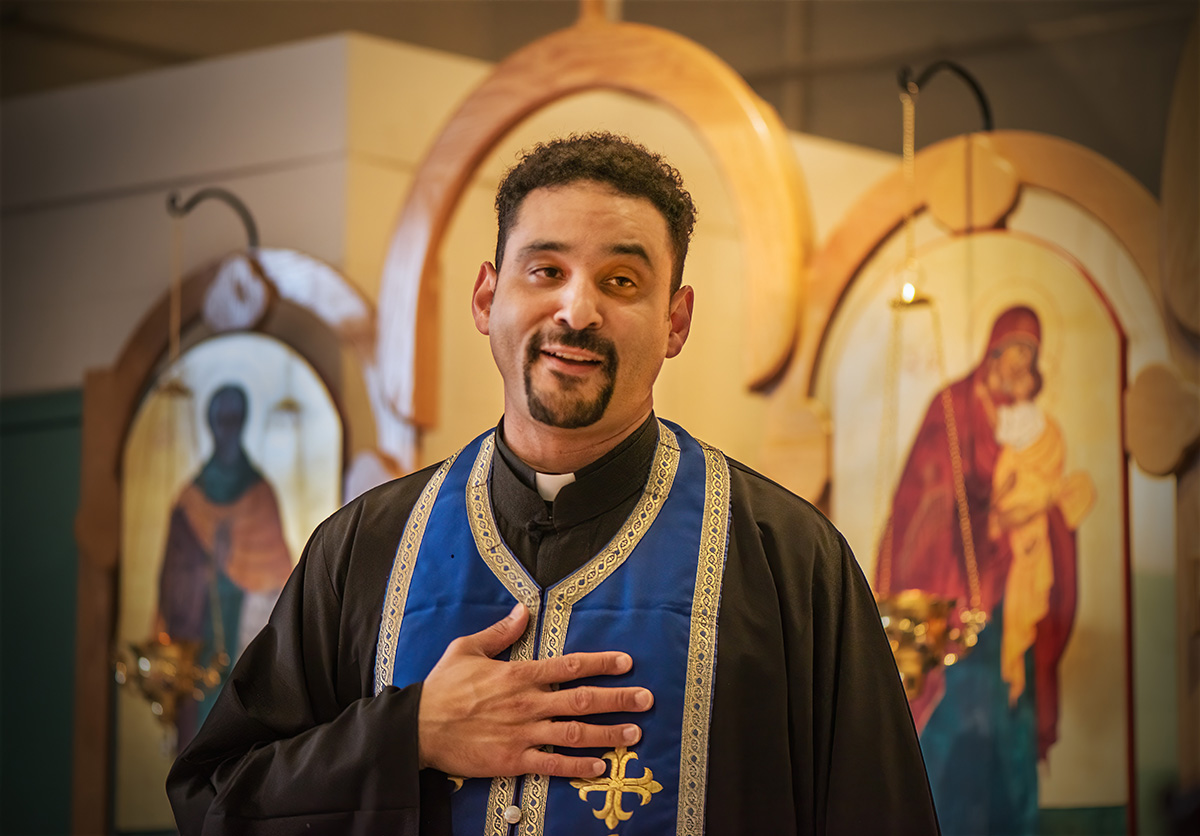
Now in its 12th year, the project offers wide-ranging services, from a food pantry, support groups and educational seminars to a trauma response team that’s dispatched after incidents of gun violence. The project serves people not just in the Hill District but throughout Pittsburgh and Allegheny County. It’s also attracted attention from a number of communities elsewhere, all seeking to learn from a model Abernathy calls trauma-informed community development.
Food, clothing and dental checkups
On a recent Wednesday morning at the Neighborhood Resilience Project’s headquarters, a three-story building on the northern edge of the Hill District, social worker Kathy Pehanich is meeting with a woman who recently lost her job and came in for help with paying her rent and utilities.
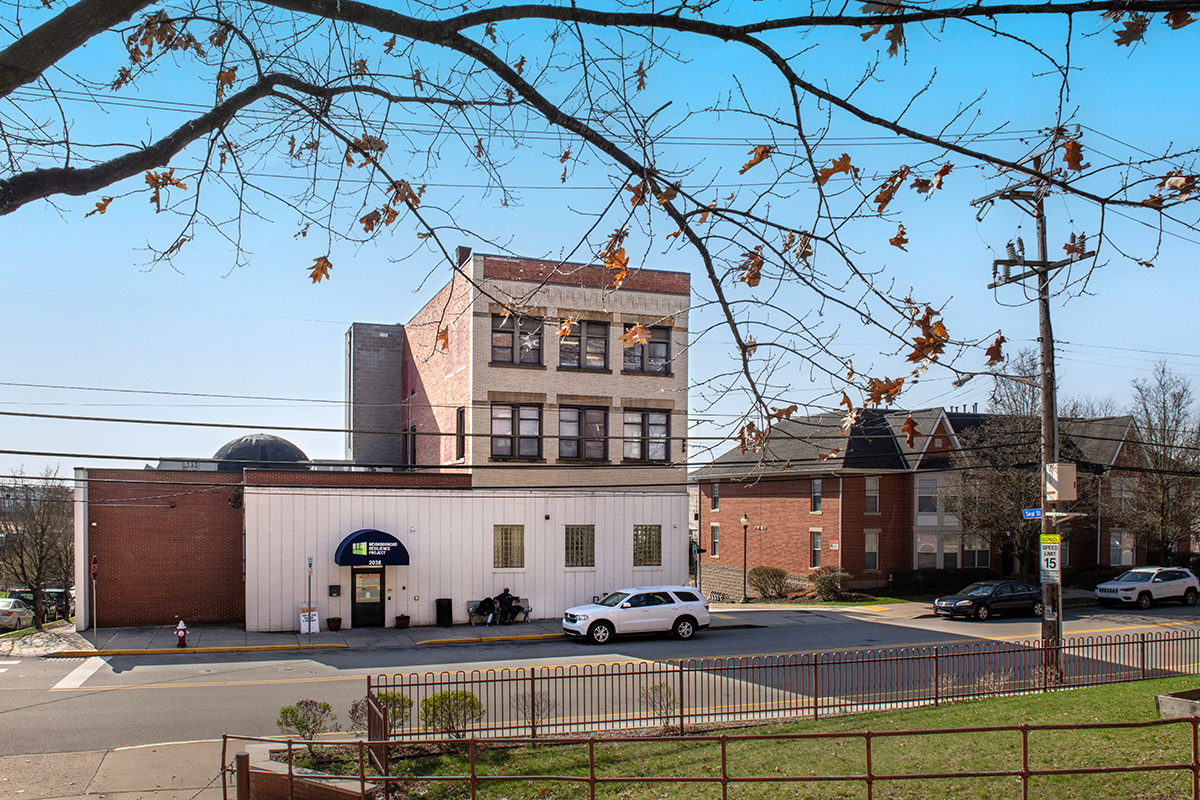
Pehanich’s office is cramped — not much bigger than a walk-in closet — with cinder block walls painted white and hung with prints of several Orthodox icons. (Orthodox iconography can be seen on walls throughout the site: St. Luke the Evangelist, St. Thais of Egypt, Christ Pantokrator, Holy Mother of God, St. Nicholas and others.) Pehanich was a drug and alcohol counselor earlier in her career; she began volunteering at the Neighborhood Resilience Project one day a week and now is part of the paid staff.
Much like an emergency room staffer, Pehanich never knows who might walk in next — perhaps a job seeker needing help getting a birth certificate, a tenant with a rent payment overdue, a woman fleeing domestic abuse. In the winter especially, Pehanich fields calls daily from people needing a place to sleep, and she works the phones in hopes of getting them beds at one of the city’s homeless shelters.
Some regulars show up a few times a week just to socialize, have a cup of coffee or attend the daily Orthodox service at noon. The steady flow of clientele creates a sense of community that Pehanich didn’t sense when she was a substance abuse counselor and saw each client once a week at most.
In the basement, volunteers and staff have formed an assembly line, stuffing food items into plastic bags for the Backpack Feeding Program. The Neighborhood Resilience Project delivers more than 1,200 bags each week to 25 area schools, rec centers and other sites, where they’re distributed to children who need them.
“For some kids, their only meal is what they get at school,” said Bisrat Tesfagiorgis, who oversees the effort. “Our program works to make sure that the children are fed over the weekend.”
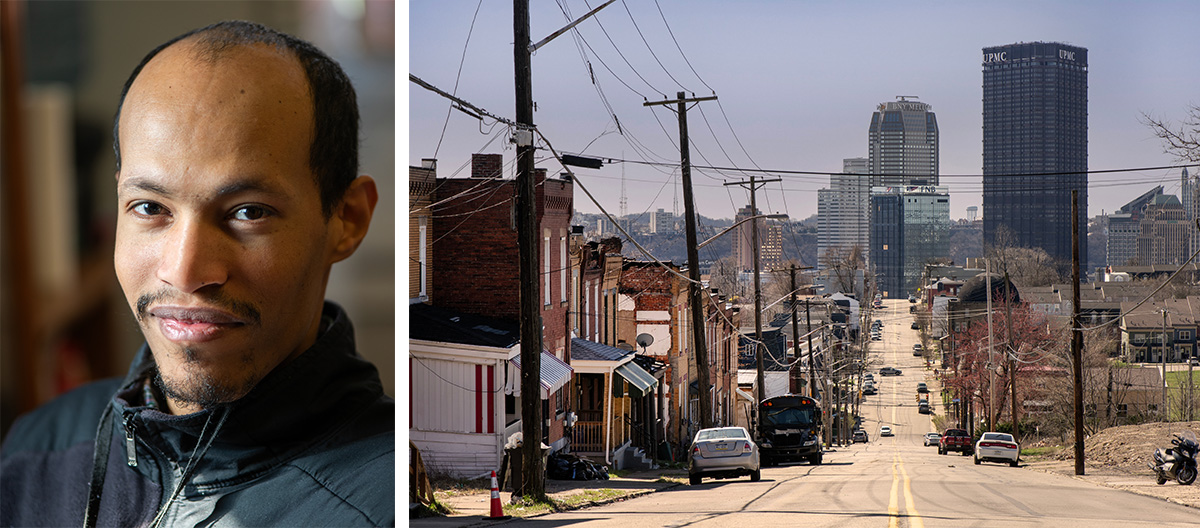
In the early years of the program, the food items (ramen noodles, macaroni and cheese, animal crackers, small boxes of cereal, boxed juice) were delivered in a backpack — hence the program’s name. But getting more than a thousand students to return the backpacks for reuse each week proved unrealistic, so now the food is packed into plastic grocery bags.
The building’s lower level also houses a food pantry and a clothing pantry (socks in particular are always in demand). Tesfagiorgis remembers a recent incident typical of the multiple ways the Neighborhood Resilience Project can help.
A man showed up one day, upset about the death of a close family member. “We were talking,” Tesfagiorgis said, “and I was just trying to pray, asking, ‘How can I be helpful?’ Then he said, ‘I wish I could go to the funeral, but I don’t have anything nice to wear.’ So I brought him down here,” she said, gesturing to the clothing pantry. The man quickly found a suit and a pair of shoes, and — at least for the moment — his mood noticeably brightened.
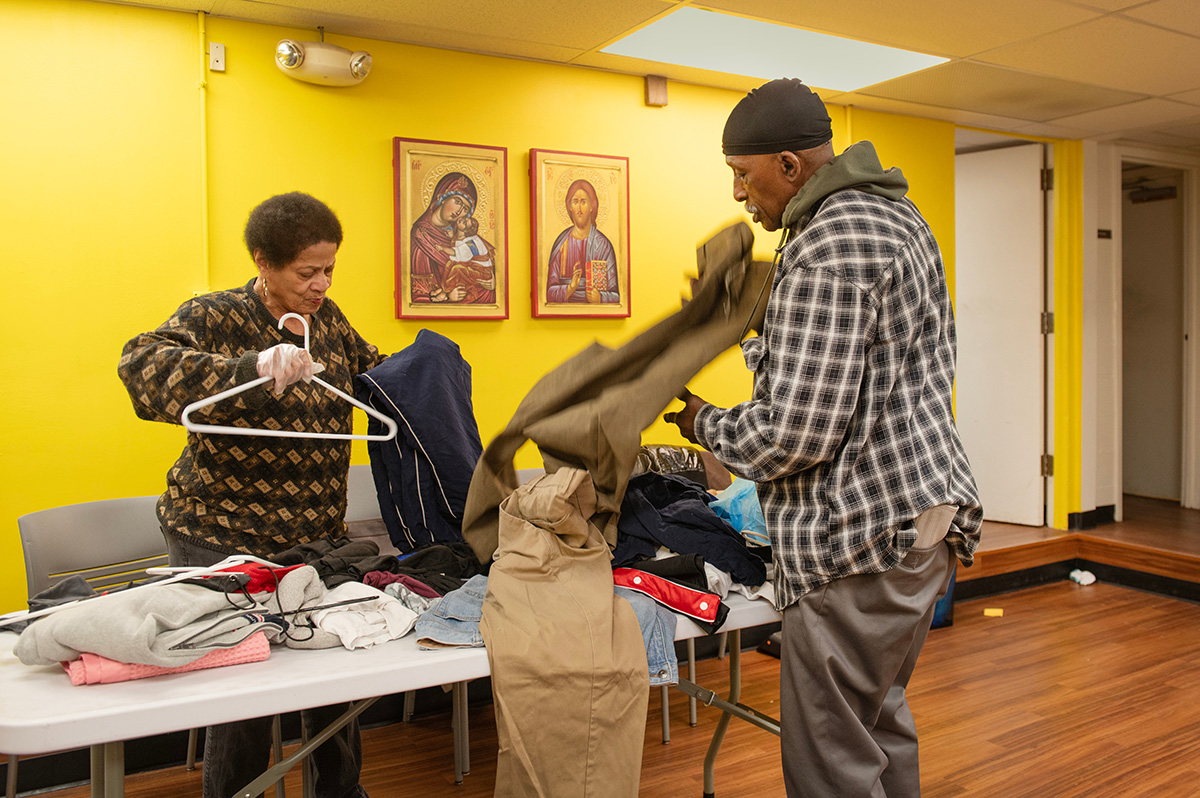
On the third floor, a health clinic staffed by volunteer physicians and dentists provides free care to a clientele that largely has no health insurance. With two exam rooms, two dental rooms and a medical lab, providers can offer a range of primary care services and make basic medications available at no cost.
For more advanced care, the Neighborhood Resilience Project can refer a patient to one of its partners — a local cardiologist who has agreed to see patients for free, for example, or another free clinic that happens to have a pulmonologist on staff. In addition, according to patient care specialist Paige Sarkaria, many area hospitals offer financial assistance.
“We can refer a patient to a hospital for, say, an imaging procedure, and then we help them apply for the hospital’s assistance program,” she said.
Like most of the services of the Neighborhood Resilience Project, the clinic has grown. In 2022, it recorded 244 patient visits; in 2023, that number jumped to 421.

The health outreach isn’t confined to the Neighborhood Resilience Project building. A team of trained community health deputies spends time out on the streets, educating residents about health issues.
During the peak of the COVID pandemic, more than 100 deputies, often with Abernathy in the lead, went door to door to talk about how to stay safe from the virus — a special challenge in neighborhoods where multiple generations live together in crowded homes. They also recruited Black volunteers to take part in Moderna vaccine trials at the University of Pittsburgh, mindful that the pool of participants in such trials too often is predominantly white.
Psychological first aid
Perhaps the most innovative service that the Neighborhood Resilience Project provides, and the one that best exemplifies its trauma-centered approach, is the trauma response team. The team’s job is simple yet ambitious: to provide a healing presence — psychological first aid, they call it — at the scene of gun violence.
Each morning, four staff members gather in a room on the top floor of the Neighborhood Resilience Project building and begin to sift through the available information on any new homicides in the county.
The intel comes from social media, police reports, news stories online and tips from police or social workers. Ultimately, the staff may conclude that a deployment is needed, and the call goes out to a team of volunteers (who, like the staff, are trained in public safety, CPR, first aid and mental health first aid).
The staff and volunteers gather at the building, undergo a briefing on the details of the situation, pray together and then head out in one of two 31-foot RVs emblazoned with the Neighborhood Resilience Project logo.
How can your ministries embrace being trauma-informed?
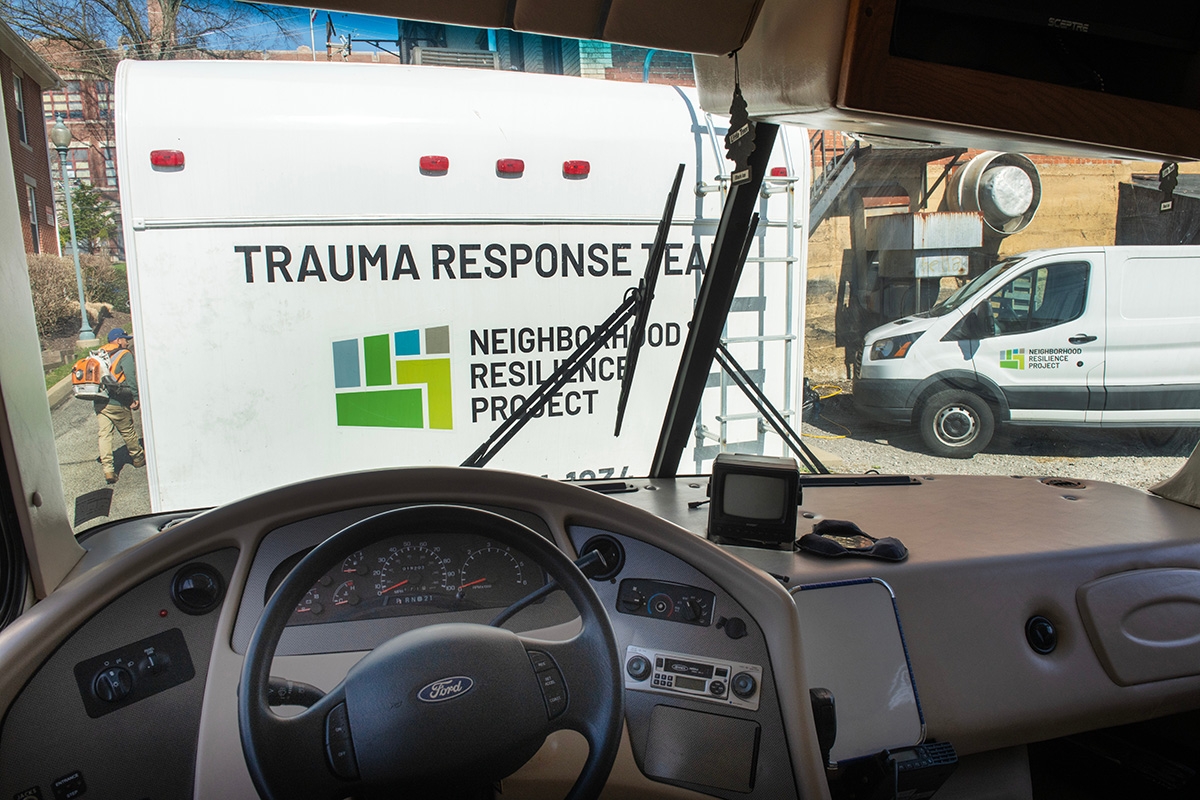
They park near the scene for several hours; some team members go out canvassing, introducing themselves to people they encounter, while others wait in the RV in case someone knocks on the door and says, “I need to talk.”
The RV has water bottles, food, a private room and stuffed animals (“trauma teddies”) for helping comfort children. The idea is to serve as a sympathetic ear to whoever needs it: a family member of the victim or perpetrator, a bystander — anyone who has been affected. Sometimes they help the person notify relatives. Sometimes they pray. Often they hand out a card with the Neighborhood Resilience Project phone number and a list of other available resources.
Andre Jacobs is program manager for the trauma response team. A native of Pittsburgh, he served three deployments with the Marines in Afghanistan and suffered afterward with PTSD. He credits his faith with helping him recover — “I had to have the courage to say, ‘I’m not OK, God,’” he said — and sees his work with the trauma response team as a way of giving back.
“I would just be foolish not to pass on the teachings and understandings that I now have,” Jacobs said. He also makes sure that the team isn’t known solely for its work at the scene of tragedies; they’ve also set up a hamburger grill on occasion at various neighborhood locations — “you know, just to put a few smiles on faces,” he said — and they conduct educational programs to help raise awareness of the trauma that often underlies violence.
A team approach to reducing violence
The Neighborhood Resilience Project is also taking the lead on a countywide project to reduce gun violence. Allegheny County sees more than 120 homicides per year on average, according to county data, and while Black men make up just 6% of the county population, they are the victims in 66% of the homicides. Gun violence tends to be geographically concentrated, according to Abernathy.
“There are 30,000 blocks in Allegheny County, and of those 30,000 blocks, gun violence happens in 0.3% of them. About 90 blocks.” Several of those hot spots are in the Hill District.
What challenges should be addressed in early collaborations?
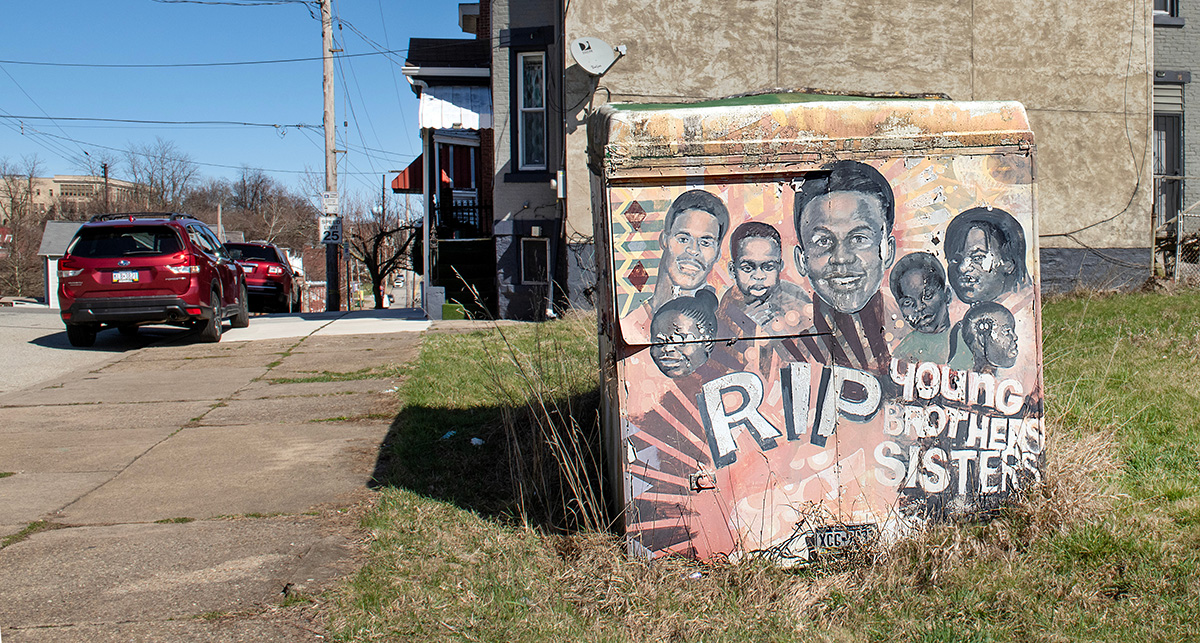
In early 2023, the county’s Department of Human Services pledged at least $50 million over five years toward its new Community Violence Reduction Initiative, with an emphasis on a public health approach — treating gun violence as a disease and addressing its underlying causes.
It’s in sync with the trauma-informed approach that Abernathy embraces, and in fact, the Neighborhood Resilience Project was chosen to be the countywide convener of the effort. The Neighborhood Resilience Project hosted the first summit on violence reduction last June, bringing together 200 partners from organizations throughout the county.
“We talked about what collaboration looks like,” said Quinten Boose, the director of violence reduction at the Neighborhood Resilience Project. “We talked about the hot spots, the data, the generational traumas, the root causes — how are we as a county going to address that.”
Boose is a former Pittsburgh city police officer with experience as a special victims unit detective and crisis negotiator; in 2023, he finished a master of public policy and management degree at the University of Pittsburgh. His job in the countywide project is to corral hundreds of partners from dozens of community and government organizations to work together.
It’s early in the process, but Boose is especially intrigued by an approach called the Omaha 360 model, which heavily emphasizes the collaboration of multiple stakeholders. A primary component of the model is weekly meetings involving law enforcement and residents, to reduce the disconnect between police and community members. Omaha 360 led to a 74% decrease in gun violence over a 10-year period in Omaha and has since been used as a model by other cities.
How do you foster a culture of continuous learning in your collaborations?
Meanwhile, the Neighborhood Resilience Project overall is proving to be a model for other communities throughout the country. In addition to his TEDx talk, Abernathy has given numerous media interviews, convened two trauma-informed community development institutes, and hosted officials from such locations as Richmond, Virginia; Indianapolis, Indiana; Sarasota, Florida; and the Wind River Indian Reservation in Wyoming.
Some have replicated the Neighborhood Resilience Project in their communities or begun a variant of it. They are exploring ways that they, too, can adopt the Neighborhood Resilience Project’s goal: to heal neighborhoods, one block at a time.
Questions to consider
- What are the underlying issues impacting your community?
- How can your ministries embrace being trauma-informed?
- What challenges should be addressed in early collaborations?
- How do you foster a culture of continuous learning in your collaborations?
Invitation to a Changed Life
As the visioning of the congregation continued, [Arlington Presbyterian Church] members connected the crisis of their own congregational life to the life of the surrounding community. In 2012, APC realized they needed to set their priorities within their call from God to the neighborhood.
We really needed to stop asking ourselves questions and start knocking on our neighbors’ doors in a sincere, committed, and organized effort.
It wasn’t enough to do the intellectual discernment processes or for the congregation to assume they knew the needs of the neighborhood.
We were challenged to pay attention not to what we thought needed to happen, what we imagined the community needed, but to listen to what our neighbors had to say — to get to know and be in relationship with our neighbors and hear them.
Congregants rode buses up and down Columbia Pike [in Arlington, Virginia]. They talked with local business owners, teachers, domestic workers, any and all who make up the infrastructure of Arlington County. On Saturday mornings, church members set up tables in the church’s parking lot, located right next to a bus stop. They used the community-organizing strategies of listening sessions and one-on-one meetings to listen to the deep wisdom of the neighborhood.
One day in one of the villages there was a man covered with leprosy. When he saw Jesus, he fell down before him in prayer and said, “If you want to, you can cleanse me.” Jesus put out his hand, touched him, and said, “I want to. Be clean.” Then and there his skin was smooth, the leprosy gone. (Luke 5:12-13)
APC listened. They heard of people covered in debt and exorbitant rent. They heard of people longing to be healed from weary commutes, financial uncertainty, and living away from family and kinship. They listened as neighbors shared hopes, dreams, and ideas for their future, a future they wanted to be in Arlington County.
This relational work allowed a guiding question to emerge for APC: What is breaking our hearts in our neighborhood?
The stories of the neighbors broke the heart of APC, binding the well-being of APC up in the well-being of the neighborhood. Jesus pulled the congregation into the neighborhood streets, and they practically tripped over the need for affordable housing as they listened to story after story.
The stories signified the emerging incompatibility with the old and the new: as we began to think about jettisoning our 1950s building, we also started to rid ourselves of the 1950s version of Christianity that had captured our thinking. Our ministry shifted from “if we build it, they will come” to “we will go to the neighbors and build.”
It wasn’t about what we could do for our neighbors; it became about how we heard God’s invitation in their stories. How their stories became our stories together. …
For More of the Story, Go Around the Corner
There is a plaque on the outside of Gilliam Place [apartment building], created by an unknown entity, that says “Here stood the Arlington Presbyterian Church.” The plaque names how APC played a significant role in the life of the South Arlington community. The end of the plaque reads, “The Church property was sold in 2016, and the buildings were demolished in 2017.”
The end. It reads like a church obituary.
Not to be outdone by a building plaque, several APC folks want to put up a sign at the bottom of the plaque that reads, “for more of the story, go around the corner …”
Creating new wine for a new wineskin hasn’t been easy, and God isn’t finished with us. Right now, APC stands in the tension between our previous stories and the ones we hope will guide us forward. As we claim these new stories, we see ourselves sharing life and evolving with those in Gilliam Place.
I now realize how our new space has allowed us to begin living a new future together with our neighbors that would have been inconceivable in the old building.
We are still dynamically breaking open those old models of church. We stand in the community, asking questions about new ways and new directions.
We commissioned a new hymn to honor this new era of APC at Gilliam Place. We sing these words often in worship:
We have been called to listen and called to act, we have been called to tear down and called to build, and we’re still people on a journey, our work isn’t done. Keep us faithful in the way of love.
This hymn is a reminder that God is not done with APC even after this miraculous story. We’re still people on a journey, drinking new wine in a new wineskin. For all of this — for the old wine and old wineskin, for the new wine and new wineskin — we give God never-ending thanks.
Excerpted from “Gone for Good? Negotiating the Coming Wave of Church Property Transition,” edited by Mark Elsdon © 2024 (Wm. B. Eerdmans Publishing Co.). Reprinted by permission of the publisher.
During the COVID-19 closures of 2020 and 2021, the leaders of Dorcas Ministries decided to remodel their popular thrift shop to look and feel like a T.J. Maxx, the off-price retailer with discounted items from name-brand fashion to home decor.
The shop, located in a former grocery store in Cary, North Carolina, was already a treasure trove for bargain buyers. The new look made it even more enticing.
The Dorcas Thrift Shop space is mostly taken up with lightly used clothing, rack upon rack, neatly organized by type. At one end of the cavernous building are multiple shoe shelves arranged by size. Handbags, belts and scarves line a wall.
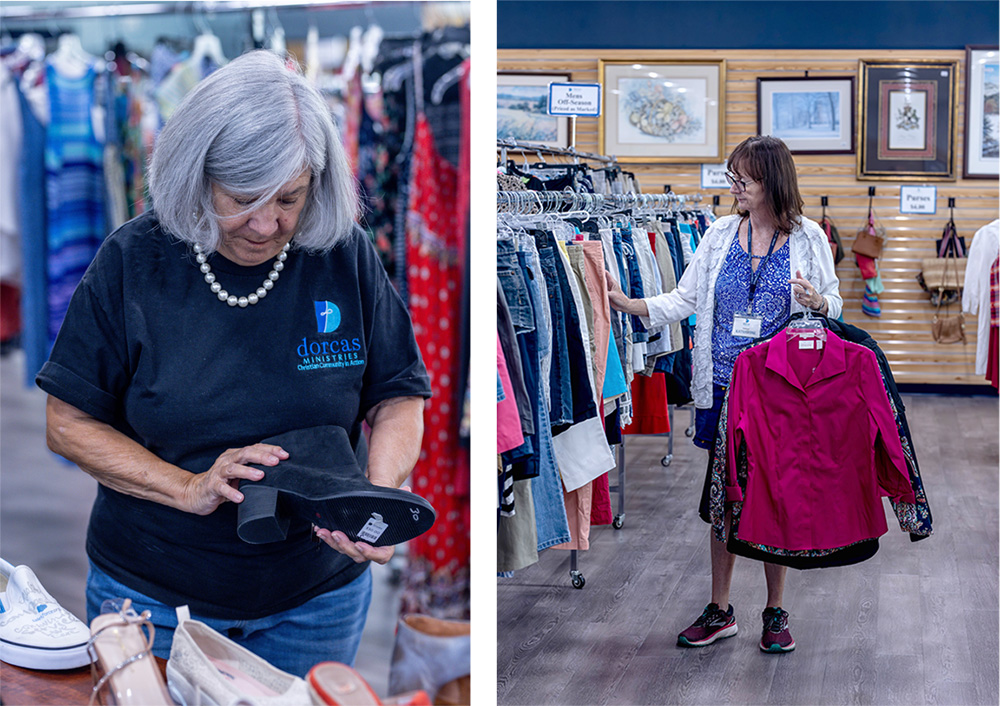
Closer to the checkout points are seasonal items — right now, Halloween costumes — and farther down, toward the rear of the store, shelves stocked high with housewares. In between, glass cases sparkle with vintage jewelry.
Customers flock to the shop from all over Wake County and the surrounding region. After browsing with shopping carts or tote bins, they pay in cash or with credit or debit cards.
The average cost of an item? $2.50.
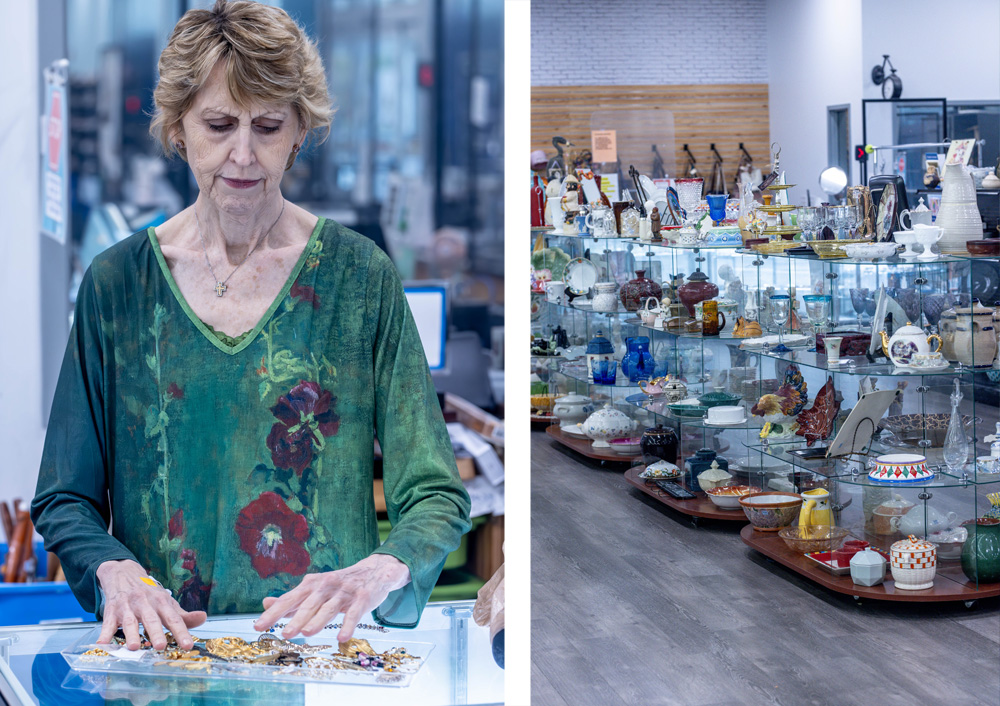
There’s a reason the thrift shop, which anchors a plaza owned entirely by Dorcas, tries to model its services on professional business practices.
The ministry sees that as a way of treating people of all income levels fairly and eliminating barriers to social mobility.
“Our job is to treat everyone like God’s children, with the compassion, dignity and respect they deserve,” said André Anthony, the ministry’s CEO. “That’s our primary focus.”
Volunteers help neighbors thrive
That formula appeals not only to low-income shoppers but also to a healthy corps of middle-class volunteers from Cary and Morrisville, affluent suburbs of North Carolina’s capital of Raleigh, who have helped make the ministry a success.
The ministry takes pride in having earned Top 10 ratings in the “Best Thrift Shops” category on Yelp, the crowd-sourced review platform. On a typical weekday morning, several dozen people wait outside the shop ready to make their way in as soon as the doors open at 11 a.m.
Started 55 years ago by a group of women from nearby churches, the ministry takes its name from the seamstress Dorcas, mentioned in the book of Acts as “always doing good and helping the poor” (Acts 9:36 NIV).
Last year, the shop generated $3.2 million in sales. It used that income to provide $2.2 million in financial assistance to the area’s poor, becoming a premier social welfare agency for a region of more than 200,000 people.
Dorcas employs 27 full-time staff, but it relies on 600 dedicated volunteers, without whom it could not fulfill its mission of “helping neighbors thrive.” Its volunteers, many retired from careers as IT specialists, corporate executives and health care professionals, are eager to give back to their community.
What compelling vision does your organization use to inspire volunteers?
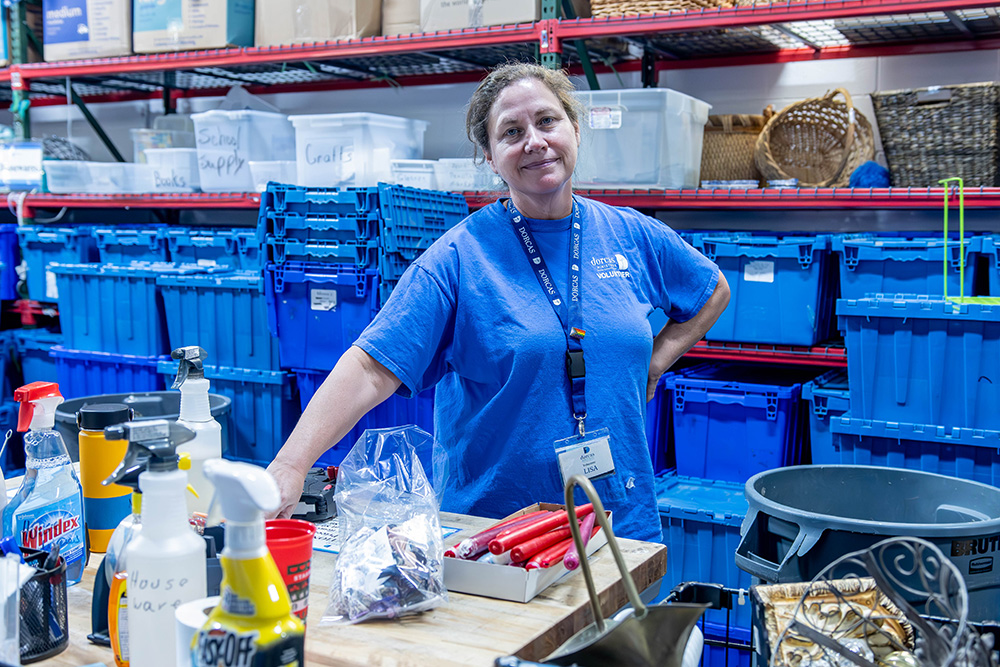
Some 500 of those volunteers take one or two weekly three-hour shifts sorting, cleaning, fixing, pricing and labeling the avalanche of donations that accumulates daily at the shop’s rear dock.
Impressive as it is, the thrift shop is just the foundation of a vast set of services that Dorcas offers with income from the store. That’s where about 100 additional volunteers with experience working with people in difficult life circumstances apply their talents.
In 2022, Dorcas helped 2,000 families (or about 5,800 individuals) with emergency financial aid and other services at its crisis center located in offices next to the thrift shop. Those helped are typically low-wage workers living paycheck to paycheck who, because of divorce, illness, the birth of a child and/or lack of paid parental leave, fall behind on their rent or are facing eviction.
“Dorcas is probably the most significant social ministry in our area in terms of how many people they serve and the kind of services they provide,” said the Rev. Wolfgang Herz-Lane, the senior pastor of Christ the King Lutheran Church in Cary, one of 40 area congregations that regularly donate financially to the ministry.
Christ the King provides Dorcas with a steady stream of volunteers and refers people in need. So much so, Herz-Lane said, that he thinks of it as a “social ministry arm of our congregation.”
Helping people in crisis
Like the thrift shop, the Dorcas crisis center is modeled on an ethic of respect and dignity for all. A receptionist greets people and directs them to private rooms where they meet with case workers to assess their needs and come up with plans to address their financial difficulties.
How do you communicate your vision and invite potential volunteers to be part of it?

Clients at the crisis center receive checks — usually within 48 hours — to help pay for rent or utilities. Dorcas may even help pay for veterinary care (addressing the No. 1 reason pets wind up in shelters — families’ inability to pay veterinary bills).
But the aid doesn’t stop there. Clients receive ongoing counseling and other services for a period of three months to a year. That may include one-on-one career coaching, cash stipends for those willing to enroll in workforce training classes at the local community college, or preschool scholarships for children.
“We don’t just hand them a check for rent assistance; we hand them a check and say, ‘OK, let’s talk through some changes that can be made,’” said Sally Goettel, a former Dorcas board member who continues to volunteer there. “By getting that holistic approach, it’s just so much more effective.”

At the crisis center, clients can also take advantage of a mobile University of North Carolina nursing clinic that provides free basic preventive care, including school physicals, every Tuesday morning and twice a month on Saturdays.
But the most basic form of support the ministry provides is food.
Food assistance for families in need
Similar to the T.J. Maxx-inspired thrift shop, the Dorcas food pantry, located a few doors away, is modeled on a high-end food store. Dorcas clients can take a cart and browse a wide selection of prepared foods as well as fresh fruits and vegetables, dairy items, baked goods, paper goods, diapers and even cat food. Grocery shelves are labeled in English and Spanish. Recently, the pantry started a Taco Tuesday meal kit. (About 8% of Cary residents are Hispanic.)
Here, too, the idea is to treat people with respect — not just to give them a handout. While anyone can shop at the Dorcas thrift shop, the pantry is reserved for families in need who have gone through its client services intake.
“It’s not a preselected bag of food,” Anthony said. “It’s very much client choice. It’s intentionally set up where, when you walk in, you feel just like anybody going to a grocery store.”
If you have an idea for Christian social entrepreneurship, could it be supported with an active volunteer base?
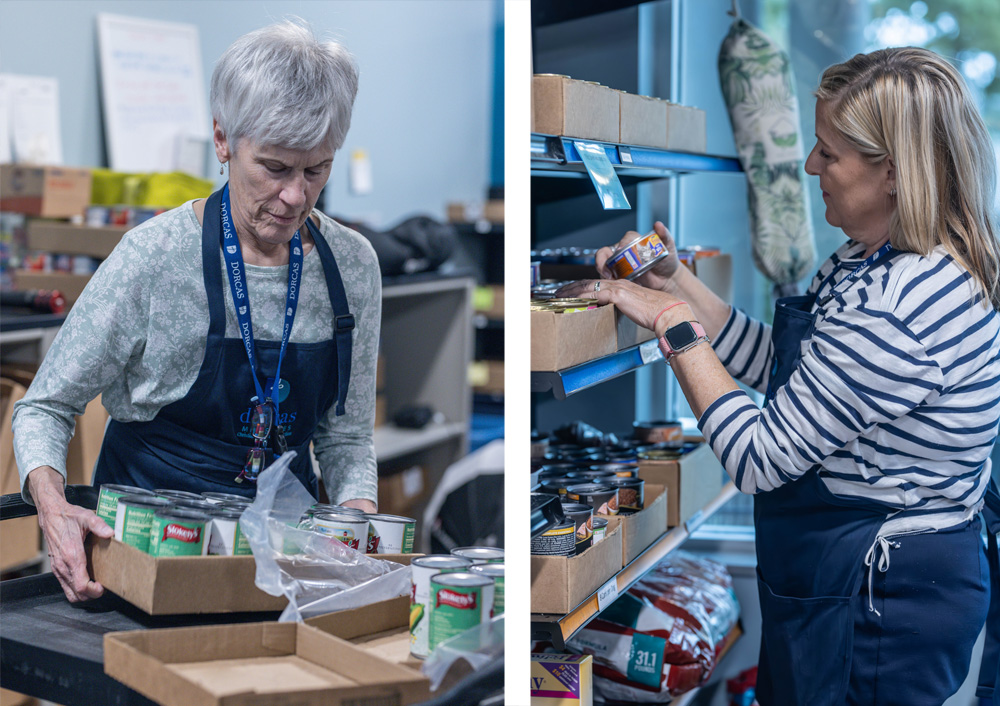
Sallie Whelan, a retired schoolteacher, said it’s the interaction with clients that makes the food pantry such a satisfying volunteer experience.
“I wanted to do something in my retirement that would go towards my philosophy of helping people,” said Whelan, 67. “We’re working directly with the people that are shopping — helping them find something that they’re looking for or explaining the process to them.”
Founded on faith and dignity
While the ministry is motivated by the Christian faith of its founders, the employees and volunteers do not ask clients about their faith and only mention its Christian roots if asked. Among the 40 congregations supporting Dorcas, one is a synagogue; another, a Hindu temple.
“Whether they’re Christian or whether they’re Hindu or whether they’re purple or whether they’re green, if you want assistance and you live within the geographic region that Dorcas supports, they can assist you along a path,” said Barbara Bostian, 66, who volunteers as a career coach and serves as vice chair of the ministry’s board of directors.
That desire to help neighbors is how Dorcas got its start. In 1968, a group of mostly white women from Cary’s downtown churches that had been meeting for a Bible study decided to add a service project.
Southern schools were still segregated in those days, and the women decided to form a class for Black children who didn’t have access to kindergarten.
They drove through town, stopping at homes where they spotted a clothesline with children’s clothes or toys on the front lawn. About 40 children eventually enrolled and met at a local predominantly Black church.
Thus was born Christian Community in Action, still Dorcas’ legal name.
How does your faith community offer support while maintaining the respect and dignity of its neighbors and clients?

Soon after the program began, people started donating clothes for the children, and a small clothing closet was set up. To help preserve people’s dignity, CCA began charging people a nickel or a dime for each item. This was the start of the Dorcas Thrift Shop.
“They started putting money in a jar,” said Jill Straight, Dorcas’ senior director of client services and advocacy. “And then when one of the families they were working with needed help with a light bill or water bill, they used the jar of money to help with the bill.”
By 1972, the thrift shop transitioned from a church closet to a downtown apartment. The kindergarten program ended in 1980, but the thrift shop continued to grow.
After moving half a dozen times, the ministry bought an old strip mall in 2008 and invested more than $4.5 million in building upgrades. It rented out adjacent spaces to other nonprofits, including a Habitat for Humanity ReStore, an after-school literacy program and a behavioral health care management group.
Dorcas Plaza also includes a few for-profit businesses — one of which, a pool hall, has been a good neighbor to the ministry, contributing money through fundraising drives.
These sound business decisions have helped the ministry boost its volunteer roster. Each week, a Dorcas staff member conducts an orientation tour for potential volunteers. On a recent Tuesday, those included a handful of retirees and a young man with developmental disabilities.
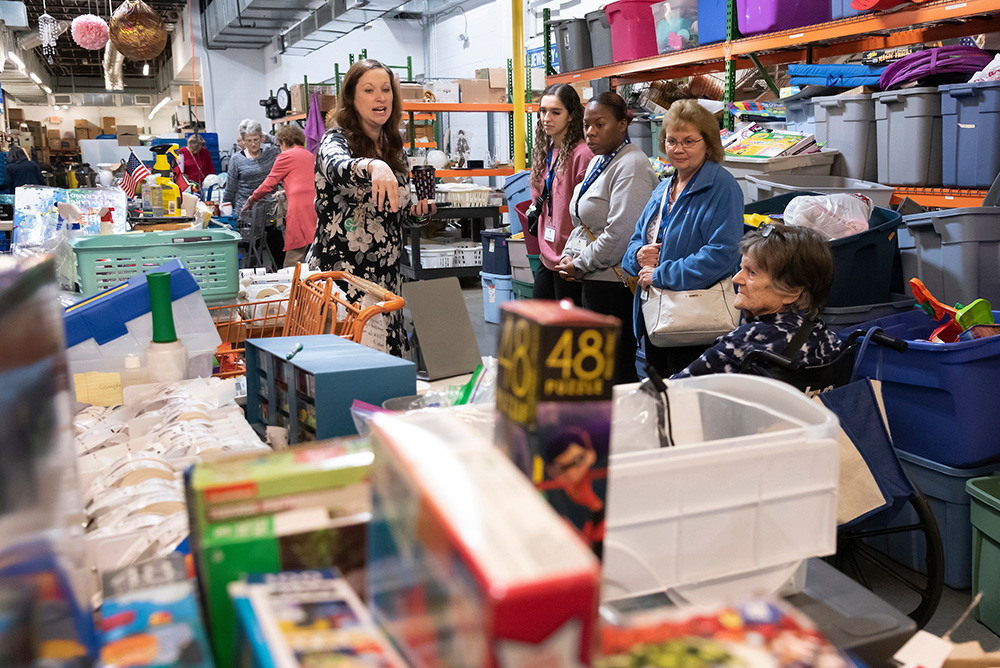
Shelley Hobbs, Dorcas’ director of marketing, gave the group a behind-the-scenes tour of the thrift shop, the food pantry and the crisis center.
All were familiar with the Dorcas Thrift Shop, and several said they had shopped there for years. One of them, Carolyn Jungclas, had recently retired from a career as head of procurement for First Citizens Bank.
Jungclas, 60, described herself as a crafter who loves to sew. She wanted to volunteer to sort through the linens and fabrics the thrift shop receives. A friend had told her that Dorcas could use her help.
“I’m a firm believer, from the Gospel of Luke, that to whom much is given, much is expected,” Jungclas said.
But what impressed her most was the ministry’s emphasis on treating people with dignity.
“To me, that just is so key,” Jungclas said. “I’m hoping to start as soon as possible.”
How do your volunteers describe the work of your organization? How do they describe working for your organization?
Questions to consider
- What compelling vision does your organization use to inspire volunteers?
- How do you communicate that vision and invite potential volunteers to be part of it?
- If you have an idea for Christian social entrepreneurship, could it be supported with an active volunteer base?
- How does your faith community offer support while maintaining the respect and dignity of its neighbors and clients?
- How do your volunteers describe the work of your organization? How do they describe working for your organization?